At Last, It Can Be Told |
by Matt Murray
Oh, so you want to know about this film, eh? Well, pull up a comfy chair. This may take a wee bit of time.
The Ozone Commandos, at least as a film, was my brilliant idea. I had just purchased a Panasonic AVE-5 video switcher for use in creating post-production effects for Men In Black vol. II, a project which was in the process of dying just as I finally saved up the needed cash for the contraption in question. Faced with nothing to put the hard-earned thingamabobble to work on, I hit upon the idea of making a movie adaptation of Dave Merrill's self-published comic The Ozone Commandos, or at least of issues three and four. The comic, for those of you not in the know (that being all of you, I suspect, though you can read a few issues here to see what the deal is) featured (extremely) thinly veiled versions of the CPF gang as a bunch of futuristic smartasses with a gigantic assault blimp who fought the evil, evil forces of video pirates, worldwide conspiracies to make entertainment media sucky, and obnoxious SF fans. Several of us, embarrassingly enough, did the cosplay thing back then, and our comic counterparts were costumed accordingly. I recall that my initial pitch to Dave regarding the whole idea went about like this:
"It'll be easy. We've already got the costumes, we can shoot the fight scenes at cons (one key story event involved the infiltration and destruction of a floating SF con), I can kit-bash a model of the blimp, Jeff (Tatarek) can build the robot suit-he's always wanted to make one-and it'll have a small cast (compared to M.I.B. II, this was true). It'll be a piece of cake!"
Piece of cake, indeed. The phrase "kit bash a model of the blimp" alone represented several months of work.
What follows is a timeline of the events relating to the production of OZC, as near as I can recall them. Some dates given are approximate.

Late spring 1992: The first ever shoot on OZC: some establishing shots of the area of Atlanta known as Little Five Points, which the Commandos' underground base lies beneath. An easy success in creating a composite of the Floating Con, lair of the Commandos' enemies, by split-screening between the Atlanta skyline on top and a mound of dirt (shot upside down) on bottom contributes to the early notion that the film will work out smoothly and simply.
June, 1992: The gang makes a trip to Mobile, Alabama to shoot footage of the battleship Alabama, converted to a tourist attraction. Shots of full-size deck guns and other structures will eliminate the need for extremely close and unconvincing model shots of same. A great deal of interior footage is shot, as well.
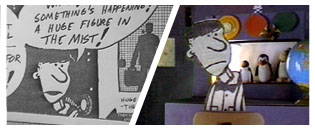

July, 1992: Shooting the "attack on the con" scene commences at Atlanta Fantasy Fair. Of the original eight comic characters, two we rarely saw anymore (in real life, that is), one was elsewhere at that point in the story, one needed to be elsewhere (Chopper), as his costume (which hadn't been made yet, anyway) wouldn't allow him to see where he was going, one (Iggy, seen as a repeated xerox in the comic and as a cardboard cutout of the same xerox in the movie)
had yet to be made,
and two had shown up
without costumes for now-forgotten reasons. I alone had come dressed the part. 
 To compensate for our bad planning, our friend Laura Block, attending the con in her Sascha (from Be Forever, Yamato) costume, was invited to join the production to bolster the attenuated cast. It was also decided to make Dave Merrill's costume be simply the clothes he happened to have on that day.
To compensate for our bad planning, our friend Laura Block, attending the con in her Sascha (from Be Forever, Yamato) costume, was invited to join the production to bolster the attenuated cast. It was also decided to make Dave Merrill's costume be simply the clothes he happened to have on that day.
July, 1992 (two weeks later): Better prepared, the attack scene filming continues at Dragon Con with the cast of myself, Dave Merrill, Laura Block, Iggy, and Dave III (whose shtick is that he changes frequently between different anime personas, requiring multiple costumes).  Random passers-by are recruited on the spot to play the con's ill-fated defenders. Needed connecting footage is still lacking.
Random passers-by are recruited on the spot to play the con's ill-fated defenders. Needed connecting footage is still lacking.
Late summer/early fall 1992: Work begins on an actual screenplay, written largely at an IHOP. The idea is floated to possibly spilt the film into two parts, as it is already clear that the production will be quite long.
Fall, 1992: Crowd footage is shot at Phenomicon 2 for use in bad guy Shadow Rollins' oratory to the masses of fandumb. A plan to use Bruce Lewis in the part of Rollins fails due to lack of time, or a costume.
Fall, 1992: Construction of the model blimp begins. Unable to locate a zeppelin or blimp model, we settle for a Red October submarine model. The upper deck is fashioned from a battleship Missouri kit, with minor changes made to match the structure of the Alabama.
Fall, 1992: First shooting session of blimp interiors commences in Dave's garage, beginning with the scenes of my character, Captain Hardluck. Shots are primarily tight and low-lit to disguise the lack of a full-sized set. The results are not particularly good.
Fall, 1992: I acquire an add-on device that will give my AVE-5 switcher full luminance keying capacity. Tests prove successful, but lighting is critical.
May, 1993: At Project A-Kon 4 in Dallas TX, scenes of mass fanboy carnage are staged and filmed in the hotel lobby.
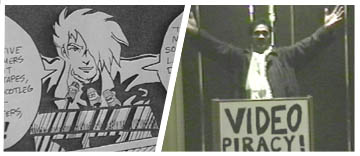
June, 1993: The crew returns to the Atlanta Fantasy Fair to finish off shooting of the con assault scenes, which are finally completed. Stan Dahlin is cast in the previously vacant role of the villain Shadow Rollins.
July, 1993: At Dragon Con, additional footage of fanboys dying is filmed, and an unused panel room and podium are commandeered for the first two Rollins scenes.
August, 1993: Footage is shot for the kung-fu fight portion of the film. Yes, you read that right.
No, not a good kung-fu fight. A really bad one.
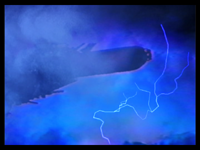

Fall, 1993: More kung-fu footage is filmed. The model of the Ultradeath Assault Blimp is finally completed. Work begins on designing and building a "black room" for creating the ship interiors via luma-key. A console which could be redressed and used for both the Chopper and Sascha characters is built.
Fall, 1993: The film's opening FX shots are completed, featuring an unprecedented (for us) six element composite of the blimp approaching through a storm at night.

Winter, 1993: All shots involving Chopper alone on screen are filmed. Similar shoots for Captain Dave and Sascha follow shortly, though a microphone snafu leaves half of Dave's scenes soundless. A white captain's coat and hat are added to Dave's costume for the on-ship scenes to cover his black T-shirt and dark hair, which the luma-keyer would otherwise render transparent. It also turns out that Laura's hair wasn't naturally blond, and has started turning brown again. We hope people will blame it on the low interior lighting. We realize that my all-black Harlock costume will never be keyable, no matter how intensely it is lit. At around this time, a new prosumer geegaw is announced, which will feature full-fledged chroma-key. We plan to get one.
January, 1994: With the release of the chroma-key endowed MX-1 being constantly pushed back, we proceed to decorate the black room with bright green fabric and shoot the Captain Hardluck and Dave closeups again anyway. The MX-1, when it finally arrives, is unable to key any of the shots.
Remainder of spring, 1994: We try and fail to compensate for the poor keying results, from smoothing out the fabric to changing the lighting setup in a dozen different ways. More kung-fu is shot.
May, 1994: With A-Kon 5 fast approaching and people expecting to see the results of the film we had been shooting there the previous year, I quickly put together a three minute trailer utilizing the small portion of assembled film, a few FX tests, and bits of the individual character shoots from the luma-key sessions. Reaction is positive, but hopes at CPF are at an all-time low, though not the lowest that they will ever be.
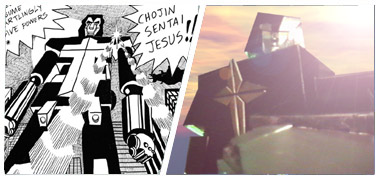
July, 1994: Jeff Tatarek arrives for Dragon Con and brings the completed robot suit for Chojin Sentai Jesus, C.B.'s alter ego in the film. We finish the kung-fu scene. The trailer is updated to include the Jesus suit. We conclude that the green fabric will never produce keyable results, and plan to panel the basement with green-painted sheets of plywood.
Late summer/fall 1994: The "commandos HQ" and "invading gravity control" scenes are completed. Construction begins on the model for the cavernous bridge interior.
Nov. 1994: The messages from "Space Goddess XK-72" (an obscure Blake's 7 reference, should you care), are filmed when my friend Eileen Heath visits from Texas.
Spring, 1995: 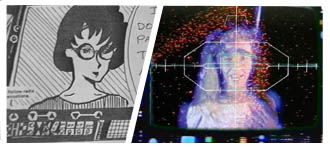 After nearly eight months of work, the "green room" is finished. Live tests are far improved, but keying from recorded images still looks like shit. The model bridge is incomplete, so keying live isn't an option. With Laura about to move to New York in only a month's time, we take a desperate gamble and pool our funds on a Sony VX3-3CCD Hi8 camera, hoping the increased resolution will solve the problem. Fortunately, it does. The catch: the camera has one red pixel permanantly on. Luckily, it goes unnoticed in the bright lights of the green room. All shots including Laura are completed in two shoots.
After nearly eight months of work, the "green room" is finished. Live tests are far improved, but keying from recorded images still looks like shit. The model bridge is incomplete, so keying live isn't an option. With Laura about to move to New York in only a month's time, we take a desperate gamble and pool our funds on a Sony VX3-3CCD Hi8 camera, hoping the increased resolution will solve the problem. Fortunately, it does. The catch: the camera has one red pixel permanantly on. Luckily, it goes unnoticed in the bright lights of the green room. All shots including Laura are completed in two shoots.
May, 1995: An "Ozone Commandos Sneak Preview" is cut together and shown at A-Kon 6, this time featuring some actual scenes from the film. The camera is sent to Sony for repairs to the screwy pixel and is not returned for eight weeks. A few matte paintings are finished in the meantime.
Fall, 1995: The Year of Hell begins. The camera is returned, but shortly thereafter the MX-1 also breaks down and must be returned for repairs. It is sent back a scant week later, but in worse condition than before, and is consequently returned once again.
Dec. 1995: The MX-1 is finally sent back to us after a lengthy "repair" job and is found totally non-functional. Words are exchanged with the manufacturer, and a replacement is sent. Later that same damned day, the camera is discovered to be still exhibiting the same flaw, and is returned to Sony a second time.
Jan-April 1996: The camera comes back still screwed up and must be sent back to Sony two more times before the bad pixel is finally fixed. During this time, the editing deck breaks down and is in the shop for two months while the back-ordered part is awaited. Shortly after its return, the tape drive of the camera breaks down and is sent to a local shop for reparation. Equipment Entropy Year finally ends.
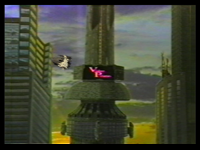
Summer, 1996: Assemblage of the film begins to push forward in earnest, with missing shots being filmed as needed. The bridge interior model is completed; for the sake of time and effort, I only completed one side wall, using mirror imaging to show the entire room.
Fall, 1996: The remainder of Dave Merrill's scenes are finally shot, some for the third time, for which he had to grudgingly shave his goatee. A second command console, which would be redressed and alternately used by myself, C.B., Dave III, and Iggy is built. All scenes of Iggy at his post are completed. Easily.
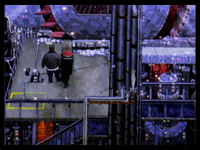
Fall, 1996-fall, 1998: Film assemblage moves along at an unprecedented rate. New effects, models and paintings are created as needed. All shots of C.B. at his post are completed. Finished portion of film grows from three minutes to twenty. Sound effects are still absent.
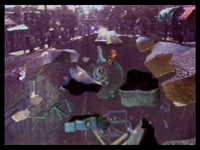
Winter, 1998: FX needs begin to exceed the capacity of my equipment. We begin using more computer technology to address the complex scenes of mass destruction in Little Five Points, with shots including up to thirty-seven elements.
Spring, 1999: Post-production is suspended as we attempt to find the means to assemble the entirety of the film in-computer. All scenes of Dave III, with his multitude of costumes, are completed.
Spring, 1999-Summer, 2000: Despite many efforts, my aging Mac is incapable of being upgraded to the point where it can handle the volume of data needed to store all of OZC. A new computer is needed, but not affordable.
Summer, 2001: A new(er) Mac is finally acquired. It promptly begins acting in an aberrant and unstable fashion. Problems persist until fall, when most are finally solved or inexplicably disappear (though unfortunately, not forever).

Fall, 2001-Spring 2002: With a large hard drive installed in the computer, large portions of the edited-on-tape body of OZC are imported from the original VHS master and cleaned up where necessary. Laura's hair is digitally changed blond again to keep continuity straight. Sound effects are also added. Cleaned-up FX are significantly improved over their initial versions.
Spring, 2002: Work begins on a 3-D modeled version of the Floating Con, which will hopefully enable us to show the structure from any desired angle. Problems arise when the file becomes so large that the computer cannot re-open it.
Spring, 2002-Spring, 2003: Most of the remaining footage from the VHS version is digitized and brought up to spec.
March, 2003: With nearly all previously edited footage digitized and cleaned up, the hard drive crashes and must be sent for emergency recovery. All data is saved, but the cost of recovery eliminates any possibility of affording a newer, better computer in the forseeable future. Work begins anew. The file for the 3-D Floating Con inexplicably becomes openable once more.

June, 2003: All previously edited footage is digitized and cleaned up; progress on new effects begins. (Note for purposes of clarity: "effect" refers to "any shot in the film.")
August, 2003: The first shots of the 3-D Floating Con are completed. Judging from the length of the completed portion, I consider the possibility of moving the dividing point between parts one and two considerably earlier so as not to end up with a far shorter second film, as well as having a part one which might be completable by fall. This plan dies a horrible death when the computer's drive crashes AGAIN and cannot be recovered. All work completed since last recovery is lost. Plans are made to lynch Steve Jobs.
October, 2003: I decide to jump platforms and move from Mac to PC. I get a Dell laptop as a backup machine, while Neil Nadelman begins building me a new desktop system. The Floating Con CG model, all but lost in the last crash, is begun once again.
January, 2004: For reasons no one seems to be able to figure out, there appears to be no way whatsoever for the files from my decrepit Macintosh to be moved to any other computer, period. All projects are put on hiatus.
May, 2004: By some means entirely too complicated to bother relating (also I don't understand it myself), the digital files for the completed sections of OZC are translated to standard DV format and moved into a new PC. The Macintosh days are forever behind me. Work continues on the CG Floating Con, now modeled much more closely on the actual Atlanta skyline. Dave re-records the lost audio for the soundless portion of his first shoot. Yes, the one done back in 1993. Shut up. Nevertheless, the prospect of having to entirely redo some three months' worth of painstaking work leaves my enthusiasm for the project almost completely gone.
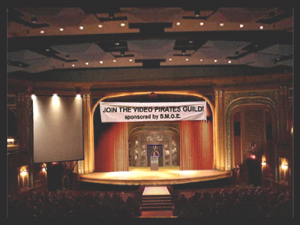
August, 2006: After three years on hiatus, the first new sequence of Ozone Commandos since the crash of the Macintosh is completed. To get myself back into the swing of things, I start with a new and comparatively simple sequence, the "Rollins addresses his hordes of geek minions" scene. The CG Floating Con, worked on intermittently during the past three years, nears completion.
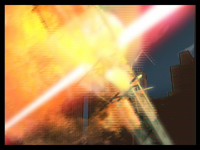
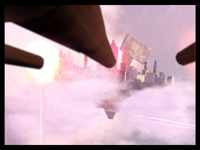
February, 2007: Another new sequence, involving an exchange of threats between the Commandos and Rollins, culminating in an all-out exchange of ordnance, is completed. The CG Floating Con, while not fully completed, is close enough to completion to allow for finished shots to be produced of certain angles. The film has reached the point where I considered halving it back in 2003 (though it has reached this point by thus far having not actually dealt with re-creating the five or so minutes lost in the Macintosh crash), but the ideal split point is still several more minutes into the battle. Reaching this point, however, will involve building a new set and shooting new scenes with Stan Dahlin as Rollins, the first new shots that will have been done of the character since fall of 1996. Work at last begins on re-creating the scenes eaten by the Mac.

May, 2007: One of the two lengthy sections of the film destroyed by the Macintosh is at last fully restored; ironically, the work is harder the second time around due to the improved resolution of the digitized footage, as the inherent grain is now compressed less than before and thus it is harder for the chroma key function to find a good, stable edge. This, along with all newly completed sequences, is archived to DVD-ROM to avoid future catastrophes. This sequence, portions of which were featured in the Sneak Preview, dramatically shows just how far our home technology, and with it the look of the film, have come since what was state-of-the-art in 1995.
September, 2007: A new 500 GB drive is installed in my computer, and I begin the process of capturing all of the Ozone footage originally shot on VHS tape to preserve it against loss and/or degradation at the hands of this thoroughly outmoded and now little-supported format.

October, 2007: Still unable to dredge up much enthusiasm for re-creating the second lost scene, I begin instead to assemble the start of the battle sequence in a piecemeal fashion, working on whatever shots most interest me and tiptoing around the still missing cutaways to Shadow Rollins and his minions. In a surprise turn, some of the Captain Hardluck shots that were filmed on the fabric green screen back in January of '94 and thought to be unusable are able to be saved via our now much more flexible chroma keying abilities. This is a boon, as these scenes were never reshot, and the console set is now disassembled and packed in my garage. These shots were originally filmed with a simpler version of the wall console set, which required a little Photoshop magic to bring it into line with the console as it appears elsewhere in the film.
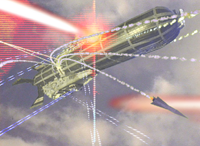
December, 2007: Work continues on the first battle sequence. Grant Goggans, who appeared in the opening credits but not in the actual film before now, records all of the dialogue for Chopper, whose costumed, on-set persona had been played by four different people in total, none of whom were Grant. All of Chopper's dialogue is completed in one sitting; lines occurring within the completed portion of the film are inserted over the temp tracks or silent spaces left for them.
April, 2008: The battle sequence is steadily coming together. Due to the large number of Floating Con shots in the sequence, I begin using a separate computer to handle the bulk of the rendering, as many of the CG shots take multiple days per second of render time, and otherwise would tie up the editing computer inordinately. One shot includes a 3-D modeled Shadow Rollins, complete with an actual image of Stan's face mapped on for realism.
July, 2008: I manage to snag several thousand dollars worth of outdated AV equipment for absolutely free when the television station I work at converts to an all-computer system and piles all the old equipment on the scrap heap. These consoles, including the same model Grass Valley unit that appeared as the death ray controls in Star Wars, will make for a far easier set-dress for the villains' lair than previously possible. I finally get in touch with Stan, who seems enthusiastic about reprising the role of Rollins once his workload for Anime Weekend Atlanta is out of the way.
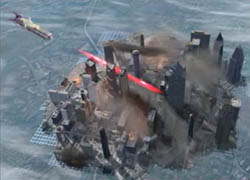
September, 2008: After years of on-again, off-again work, the CG Floating Con is finally finished. Previously missing establishing shots are rendered out and dropped into the film.
October, 2008: Barring one (as yet unfilmed) green-screen element of Rollins, the initial battle sequence is at last completed. Initial planning begins on building the villains' lair in my garage. Though there is still much work remaining on part 1, I feel confident enough at this point to set a general premiere goal for summer of 2009.
November, 2008: Work begins on the final sequence of part one, presently still avoiding any shots of the villains. The second scene previously destroyed by the Macintosh is begun again, as well. Construction begins on the model for the Magnum Opus Cannon, an enemy weapon, which will be primarily realized as a practical model in order to best maintain the established look of the film.
December, 2008: I shoot a couple of new shots with Dave Merrill during his Christmas visit for a new Ozone preview. Work continues on the final sequence and the restoration of the second lost scene.
January, 2009: All CG shots of the Floating Con needed for part one of the movie are completed. With the animation program freed up, new shots intended only for a new promo clip are designed and rendered to create a trailer that will echo the second My Youth in Arcadia trailer. Much like the first OZC trailer, it will contain copious disinformation and footage that will not be found in the film itself. But for the yet-to-be-filmed Rollins shots, the final scene nears completion.
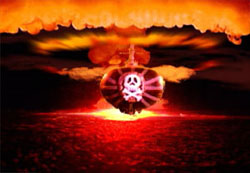
March, 2009: The new trailer is completed. A CG version of the blimp's conning tower created specifically for the trailer ends up being used for a few actual shots in the film itself. After over a decade of good behavior, the camera screws up again: this time, it will not load tapes. I hold off on taking it to the repair shop so it can be used as a direct input device for capturing elements into the computer until all needed effects elements have been shot. Preliminary work on the villains' set begins.
April, 2009: At long last, all of the scenes destroyed by the Macintosh are re-created. The camera is returned and appears to be fully functional once again. The remainder of the title sequence, including the parts which had yet to be completed at the time of the Macintosh crash, is finished and archived to DVD-ROM.
April, 2009: Less than two weeks back from the shop, the camera breaks down yet again. It's beginning to smell a lot like 1995 all over.
May, 2009: With the camera repairs delayed by the need to order new parts, I turn my attention to my "wish list" of shots to add or replace in the earlier part of the film, knocking out a few not requiring the filming of new elements. Christmas lights are wired into the AV equipment intended for the villains' HQ so as to make them appear functional (the power requirements for this equipment preclude simply plugging it into a standard wall outlet). The set is mostly completed. The camera turns out to be intermittently functional but essentially irreperable; a refurbished version of the same model is therefore acquired off of Ebay for $600. In keeping with tradition, the camera that finally arrives has a terrible picture with two red pixels permenantly on, and is shipped back for a replacement.
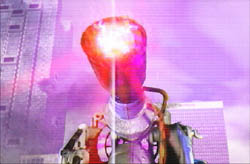
June, 2009: After languishing in a half-completed state for months, the model of the Magnum Opus Cannon is completed. In an apparent attempt to make my life more difficult, I decide to revise the ending of part one to strengthen it, which will require extensive restructuring, several more composites and a few new Floating Con shots. Forced to attempt use of the old camera, background footage of Atlanta is shot for several scenes. The camara fails again during the shoot; virtually none of the footage records properly. Rendered backgrounds are ultimately used instead, despite modeling the Floating Con on an actual city to avoid just such a necessity.
July, 2009: Another new camera is purchased off of Ebay, and turns out to have, amongst other problems, a damaged tape drive, much like our current one. It is returned for replacement. Carl Horn offers his own camera as a backup unit to help get things back in motion. The majority of shots for the new ending are completed. We finally arrange time with Stan to film the necessary Rollins scenes. The set is completed. The replacement camera arrives two days before shooting and has two burned-out pixels. We use Carl's camera and successfully shoot all the Rollins scenes needed for part one, along with a good amount of part two.
September, 2009: All scenes for part one are completed. A short teaser for part two is added to the end, for which a new CG model of an assault fighter is created. First draft of completed film is finished on September 16th and is shown to the cast and a small group of friends the following night. A few additional revisions are made, and the final version is completed the next day. The film is shown publicly for the first-and possibly only- time at Anime Weekend Atlanta at 3:00 pm on Sunday, the 20th. Owing to the fact that he is a complete, spiteful dick, my boss refuses to approve my vacation request for the day so that I might actually attend the premiere.
Ozone Commandos, Part 2:

September-October, 2009: The very next week, I begin editing on part two, beginning with the easiest sequence, wherein we infiltrate the Floating Con and shoot our way to the gravity control center. A rough assembly of the scene, including some effects work, is completed.
July, 2010: I record a hefty amount of footage of various fireworks at a July 4th get-together for use primarily in the Jesus attack on the con, to mimic the look of Japanese monster movies. This will turn out to be the last material shot for part two, and in fact the last work of any kind to be done on part two, for six years.
October, 2016: After having been more or less abandoned during the last six years due to focus on other projects (some of which came to nothing despite eating up years of work), and less than a week after lamenting that part two was never and likely would never be completed, I unexpectedly (even to myself) find my enthusiasm for the project has returned rather abruptly, and begin working once more on the "infiltration of the Floating Con" sequence, which had been worked on for a few months following the premiere of part one before being dropped around November of 2009. More sophisticated editing programs acquired in the interim show an increased ease (and therefore speed) in chroma-keying the recorded green-screen footage. Several obstacles remain: the CG fighter craft created for the part 2 preview was lost in a laptop crash several years ago. A backup copy remains, but in an incomplete state and with no texture maps, which were also lost. Work on the new version begins. The scenes of Rollins and his minions for part two were only partially completed, and the set for the villains' HQ has long since been dismantled. Several possible approaches to this problem are considered, based on Stan's potential availability or lack thereof.
Yes, I must be completely mental.
November, 2016: Work continues on the infiltration scene. The new-and-improved CG fighter craft is completed. Preliminary work begins on the scene where the Commandos enter the Floating Con's gravity control center, utilising a model that was completed twenty-six years ago (and originally intended for a completely different film) and which is still, remarkably, in perfect shape. In a typically ass-backwards fashion, I begin and virtually complete the film's final scene. There's something reassuring about seeing the film end that implies, at least at a psychological level, that it will actually be completed.
December, 2016: The first new CG Floating Con shot for the film spontaneously aborts after a week of rendering. Yes, this certainly feels like Ozone Commandos, all right. Subsequent attempts result in greater success, with several new shots completed. Remaining things to do on the infiltration sequence are listed and ticked off as completed. A few scenes of the Jesus robot, filmed during the shooting for the part 2 preview, are added into the film. A scene occurring partway through involving Shadow Rollins in conversation with the secret masters of Earth is completed. This is particularly encouraging, as no footage was ever shot for this scene, which is brought to life via some creative use of outtakes and re-purposed green-screen material.
January, 2017: New CG shots of the attack craft and Floating Con begin coming out with reasonable consistency, including those depicting the con's ultimate fate. The kung-fu portion of the infiltration scene is completed. (Features no actual kung-fu.)
February, 2017: As work continues on the latter half of the film, I assemble a rough cut of all scenes involving actors from the first half, mostly on still-unextracted green screen, to see how the remaining portion of the film will fit together in light of part 1's last-minute restructuring, as well as the absence of many of the Rollins scenes, in order to determine what gaps exist and what will be needed to fill them. Unsurprisingly, a few bits thought to have been in the bag turn out to be missing.

March, 2017: We make contact with Stan regarding the possibility of finishing his material, proposing a simple approach of recording audio-only performances that can be used over cutaways or already existing rear shots vs the prospect of scheduling another full-blown shoot. To my surprise, he picks the straightforward shoot option, which will allow for less compromise in the remaining scenes, but which will require the acquisition of a properly working camera and at least partial reconstruction of the set. Owing for the need for more close-up scenes of the Floating Con for part two, I extensively spruce up the CG model with smaller details and better texture maps. New scenes of me in costume are shot to bridge gaps caused by the reshuffling of the end of part one. A borrowed die-cast IQ-9 toy (from Star Blazers) is filmed with some simple stop-motion effects to stand in for one of Dave III's many "costume" changes. I finally manage to snag a new camera for a reasonable price off of Ebay. But for the missing Rollins-and-minions scenes (feeling much like part one here), the infiltration scene is completed.
April, 2017: Cleaving to a tradition that seems unwilling to die, the new camera proves to be unusable and is returned. At this point, I'm fed up with camera hunting to a degree I doubt will ever be overcome. I decide to shoot all new material with the old camera, using a separate device to record sound (as the camera now only records video), and sync them in post. I begin filling in effects for the initial battle sequence, adding backgrounds in place of green or black screen using the extensive catalogue of background images (the blimp bridge, sky and clouds, etc.) that are already in the computer so as to determine exactly what additional ones will ultimately be needed to complete the film.
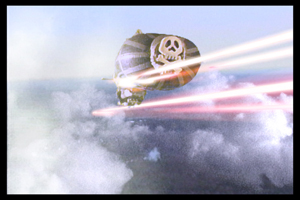
July, 2017: Work slows down a degree due to a series of power outages, several lasting for hours, which demonstrate that our current backup power supply doesn't actually work at all. The project file becomes corrupted after an unexpected shutdown; fortunately, auto-save has an up-to-date backup copy. To guard against similar calamities such as befell part one, I acquire a new backup power supply and a new hard drive for additional redundancy. Generally speaking, I avoid leaving the computer on when I'm not actively working, as several of the recent outages have been far longer than the backup can handle, making the computer all but useless for extensive 3-D rendering, which is now relegated to the laptop. The initial battle sequence is completed, minus, you guessed it, a few yet-to-be-filmed bits of Rollins and his geek lieutenants. The first new shots of the blimp model and bridge model shot since the completion of part one are filmed to finish the scene. Work begins on the giant robot fight scene-concentrating, for the moment, on the bits not involving the giant robots.
August, 2017: All remaining shots of me that utilized the old fabric green-screen are finished. All background shots of the bridge model for the remainder of part two are filmed and added in. All bridge composites for the giant robot sequence are finalized. The "strategic planning session" and "gravity control" scenes are completed.
October, 2017: A CG Chojin Sentai Jesus is created and added to the 3-D Floating Con to accomodate distant shots or shots otherwise implausible to achieve via the robot costume. A few scenes of the CG model are created, along with a couple of shots of the robot costume. A few shots of the attack craft are added, as well.
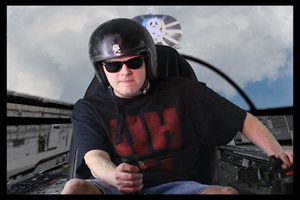
December, 2017: Rather unexpectedly, I receive a new, actually-functional camera as an early Christmas present. With Dave Merrill coming to town for the holidays, we arrange to shoot the fighter plane cockpit scenes, for which a partial set is assembled (with the rest to be filled in via the CG model). The shirt he wore for the part has long since vanished, and a replacement cannot be found, so a replica is created with stencils and spray paint. All shots of Dave in the cockpit are completed-quite agreeably, his flight helmet and sunglasses effectively hide any signs of aging, an important factor given that it has been a truly ludicrous twenty-five years since shooting began. A tentative premiere at AWA 2018 is agreed upon, on the weekend of September 20-23. Assembly of the fighter plane sequence begins. The new camera's much higher resolution reduces most chroma key operations to a mere minute's fiddling in most cases. The new footage is obviously of much higher quality than anything else in the film, but the headache that this circumvents contributes greatly to me simply not giving a damn about the image disparity.
February, 2018: The computer begins misbehaving, with Premiere becoming extremely glitchy and the computer spontaneously shutting down while attempting to play back video files. A new video card is installed, after which the drive containing the project and all related files becomes inaccessible. After this is solved, it is discovered that several folders worth of files, including around four thousand pre-rendered files for Ozone Commandos have disappeared. Data recovery is performed, and fortunately all files are saved to a new drive. Very shortly thereafter, the old drive, which was purchased only the previous July, becomes unreadable again and is disconnected.
March, 2018: Work proceeds on the fighter sequence. The computer begins spontaneously shutting off again, and this time it is discovered that it's the battery backup, the very thing that's meant to eliminate this problem, which is actually sporadically glitching out and deactivating it. A new battery backup is acquired to replace it. Work begins on attempting to clear space in the garage to reassemble at least part of the villain's HQ set to accomodate shooting of the remaining scenes.
April, 2018: All CG renderings of the commandos attack craft are completed. New shots of a saucer model created for the original film are shot to provide fodder for the dogfight with the OZC ship. Work begins on a CG model of the saucer for more elaborate shots, and ones which show the craft's upper half, which had never been previously seen and which was thus never detailed.
May, 2018: All saucer shots for the dogfight scene, both practical and CG, are completed. A mask for the Bob Dobbs robot is begun. We contact Grant to record a few Chopper lines that were somehow previously missed.
June, 2018: We get Grant's new lines and integrate them into the film. The Bob mask is completed, and a few shots are filmed and added in. I begin assembling the prologue for the film from both part 1 scenes and new material created specifically for the part 2 opening.
July, 2018: All shots of the Bob Dobbs and Jesus robots needed for the fighter sequence, as well as a few others, are completed and added to the scene. A modified version of the Floating Con with nighttime lighting is created and new shots for the prologue begin coming out.
September, 2018: That planned-for premiere at AWA 2018 goes whizzing right by.
August, 2019: After two years of pretty diligent work, output slows to a trickle as I find myself at the point of having all the hard bits remaining, and being repeatedly distracted by shorter videos which suck up the time I probably should have been devoting to the completion of this monstrosity. I suspect the film may not be completed by the year's end, though work does still continue to be done at a reduced rate, including new CG shots for the Jesus vs. Bob fight and the prologue. A new mounting stand for the blimp model is created to facilitate the blimp's final shot, which wasn't possible with the previous stand.
Return to Major Films
OR
Return to CPF F.A.Q.